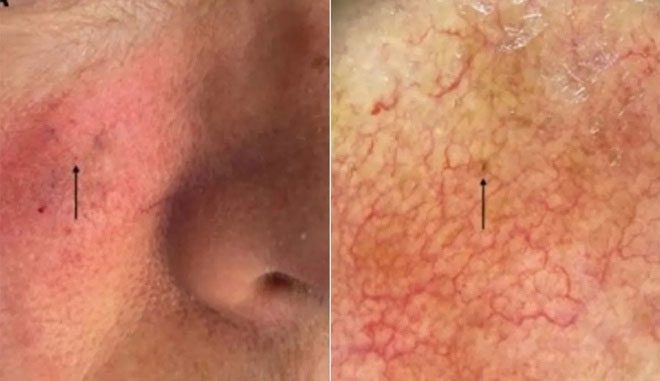This tumor existed for many years under the eye of an American patient, appearing as a red spot with a diameter of just 0.65 mm. It has been identified as the smallest skin cancer in the world.
Dr. Alexander Witkowski, a lecturer at the Dermatology Department of Oregon Health & Science University (OHSU), USA, stated that the individual diagnosed with this minuscule cancerous tumor is Mrs. Staats. Specific information about the patient has not been disclosed.
The woman reported that during her experience with Covid-19, she began to worry more about her health. Taking advantage of the magnifying mirror in her bathroom, she started inspecting her skin and noticed a few spots on it.
“The red spot on the right cheek of patient Christy Staats is so small that it is almost invisible to the naked eye,” Dr. Alexander Witkowski, who directly discovered the tumor’s abnormality, shared.

The tumor is so small it is nearly undetectable by the naked eye. (Photo: U.S. Medical Library).
Experts at OHSU subsequently confirmed it as a malignant tumor. Fortunately, this tumor could still be treated before it spread.
According to OHSU information, the spot in the patient’s eyelid was so small that a judge from the Guinness World Records organization visited the school to award each member of the research team a certificate for discovering the world’s smallest tumor.
To detect the tumor, OHSU doctors collaborated with a multidisciplinary team of dermatology experts using dermatoscopy and confocal microscopy to locate the tumor.
“The ultra-small malignant tumor was found on the top layer of the skin,” Dr. Witkowski noted that the patient was very fortunate because the cancer was detected before metastasizing to other parts of the body.
The team’s discovery has also been approved and published in the National Medical Library of the U.S. government.
Meanwhile, Mrs. Staats expressed her “gratitude” to the doctors for detecting the tumor in time before it could grow or spread. She mentioned that she also felt lucky to have discovered the illness at the “right place, right time, and with medicine having the appropriate technology for treatment.”


















































